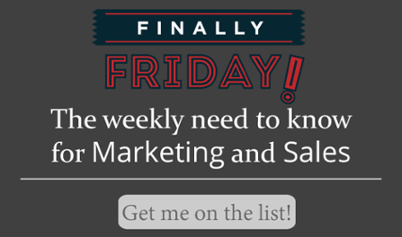Get a CLEW: The Daily Activity Dashboard You Need to Organize Yourself for Success
No disrespect intended, but based on my personal observations, few salespeople are organized, and even the organized ones are seldom organized around the task of being successful. This level of organization not only keeps you pointed in the right direction but has an empowering effect that will give you the confidence you need to tackle and overcome the challenges in your competitive marketplace.
Let me be clear: in today’s world, there are tons of tools that will help sellers get organized from a “file stuff perspective” – from CRMs, Marketing databases, SFAs (Sales Force Automation tools), Dropbox, OneDrive (and other cloud-hosted solutions) to Post-it notes. So, the problem of filing is solved but the real challenge is finding what you’ve filed.
Consider a busy salesperson who is always on the move using many different devices and typically only has a minute to find what they are looking for.
You’ll need to consider how you will file these documents so that it’s easier to locate when you’re in crunch time. That will save you tons of time and reduce stress levels. But, to be successful in sales, we need another layer of being organized. And that’s when you are organized around the task of being successful. But how?
Here is my 4-part daily system to get on track, stay on track, and position yourself for long term sales success.

Create a Daily Dashboard
The name I use for my own Daily Dashboard is “GET A CLEW” (pronounced CLUE), which is really an inside joke to myself about giving myself a clue everyday as to what I need to prioritize in order to achieve my goals.
CLEW stands for Critical, Learning, Exercise, and Writing; and the “GET A” is an acronym that stands for Goals, Expectations, Timetable and Accountable – I will explain the significance of this below.
OK, maybe you’re thinking: “Wait! If I’m not organized already, how will adding a new dashboard going to help me? That will just add yet another distraction and dashboard to maintain.” I used to think the same thing until I realized the consequences of skipping this step. Let me explain.
Have you ever made a New Year’s resolution only to completely forget it by mid-January? Have you ever felt like you’ve been making the same resolution year after year? I call that swimming in circles.
The main reason you didn’t accomplish your goals is because you took your eyes off them. You forgot to focus on them, you forgot to apply the big picture goals of your life to your daily activity choices. Instead, you reverted to old habits and patterns, which as we learn every year, brings us back to our original starting point.
My CLEW report helps remind me of my business, family, and personal goals every morning before I start my day.
I begin each day by opening my CLEW report and re-reading my goals, which are broken down into short term and long term goals for business, family, and personal. This also gives me an opportunity to assess and refine when needed. The more specific your goals are, the more likely you will accomplish them.
Each morning, I’m able to re-commit to my own Goals by reviewing Expectations of myself, my Timetable (for example: deadlines, benchmarks, and time management choices such as ending the day with one more call or email to a prospect you’re working on), and finally, my report is a daily reminder of how I need to remain Accountable for my own success and happiness.
Get into the habit of looking at this dashboard every day, even if you’re just starting with the “GET A” part first, it will point you in the right direction and set your day up for success.
Now, let’s dive in to see how we can fully “GET A CLEW.”
C = Critical
Once you’ve completed the “GET A” part to starting your day, it’s time to mentally and emotionally prepare yourself for the first big task of each day: aligning goals with daily activity.
Making a “to-do” list sounds fine but by definition is merely a list, and is typically not prioritized or scored by importance. This results in unimportant tasks mixing in with activities that are crucial for achieving your goals. That’s why I look at my Critical list of items to get done, which are arranged 1 through 10 for both my personal and professional tasks.
Every morning I cross off items done yesterday and re-prioritize the remaining items on my 1-10 scale. What a great feeling it is to re-examine my tasks every day to double check that I’m not missing anything and I’m working on the most important tasks to push me closer to my goals.
From a psychological point of view, it’s the little things that provide the greatest sense of satisfaction and empowerment: crossing items off and then adding new items to the list.
Remember that despite your level of organization, in sales there will always be more to do than time to do it. Each day you will not get to some things. Make sure you always get to the things Critical to achieving your long and short term goals by toggling between Critical and your calendar to make sure you have an appointment with yourself to do the most important things.
L = Leads and Learning
I’ve grouped these two things together because they are related.
First, if a salesperson is not spending at least a little time each day upskilling themselves about the latest trends impacting their industry, then they are falling behind. Reading industry publications including comments on discussion groups and white papers is now a necessity – if only because we have to assume that both the customer and your competitors are reading – and interested – in learning more.
Staying up-to-date works to your advantage in two ways: you’ll be the one informing your customers and prospects about the most recent or upcoming trends, and you’ll find new leads and opportunities in the process. An added bonus is that while gathering information you’ll gain greater insight into how to communicate the value of your offering.
So, to be organized around the task of learning, I work on learning in my off-hours. And rather than lose precious time deciding what to read I make a list of topics that I am interested in reading for both business and pleasure. Then, during my more relaxed times or in the early morning while transitioning from my first cup of coffee to my second cup, I review that list and select what’s on top. My goal is to “pleasure” read for an hour a day and “work” at least an hour a day.
Learning is like exercise. Always a great idea, just not at this moment. Everything in your day will pop up just in time to block you from getting to this important reading. So what’s the key to following through? Schedule time in your calendar, and stick to it!
E = Exercise
Regardless of your feelings about exercise, physical activity should be part of your everyday routine, even if it’s as simple as taking a walk around the block. Aside from the long list of health benefits, nothing will give you more of a mental boost than exercising.
In my case, I will think of the problem I’m working on and then I’ll swim for 30-60 minutes. When I get out of the pool, I come away with ideas to solve the problem. And you know what, every swimmer or runner tells me the same thing. Exercise an outlet. Are you using it to the fullest? Tell us what you think and your response may be included in an upcoming blog.
When I look at the Exercise section of my daily dashboard, I always remind myself of why I am exercising and what areas am I looking to improve? Reviewing what and why will help you stay committed to scheduling time on your calendar to exercise. A best practice of busy professionals is to exercise first thing in the morning because it helps fully energize and empower you to tackle the Critical tasks of the day.
W = Writing
While learning and reading are essential, writing is another piece of the puzzle that engages parts of your brain that push you to think harder and smarter.
In today’s world, sellers need to deliver impactful answers and examples to leave a lasting impression. You need to reassure your prospects and customers with success stories while explain new offerings to people who may know more than you or less than you. That’s why writing is a critical activity that will help you compile your thoughts, questions, and answers as you prepare for important meetings.
Spend time writing every day. What should you write? Start by writing down your most common objections and then try turning-around each objection. Answer those hard questions like: What makes your solution different? Why is it better than the competition? How is it worth the money?
Assuming your improvisational skills will suffice is a dangerous bet – especially if your competitors are following my advice and staying organized around the task of beating you. And while spending the time working out the wording on “paper” may be painful, it will result in a more prepared and well thought out response, which leads to you sounding perfect when the sale is ultimately dependent on your answer.
So if you’re looking to gain a competitive advantage and not sure where to start, “GET A CLEW” will provide the framework to help you become more organized and create a daily routine that sets you up for success.
About Steve Bookbinder
Steve Bookbinder is the CEO and sales expert at DMTraining. He has delivered more than 5,000 workshops and speeches to clients all over the world and has trained, coached, and managed more than 50,000 salespeople and managers. Steve continuously refreshes his training content to reflect his latest first-hand observations of salespeople across industries and regions. Through him, participants in his workshops and coaching sessions learn the best practices of today’s most successful sellers and managers across industries. Steve understands that sales is a competitive game. To outperform competitors and our own personal best results, we need to out-prospect, out-qualify, out-present and out-negotiate everyone else, not merely know how to sell. Through his specialty programs in Pipeline Management, Personal Marketing, Great First Meetings, 2nd-level Questioning, Sales Negotiating, and Sales Coaching, Steve trains sales teams to master the skills they need to overcome the challenges they face in today’s world… and keep improving results year over year.





